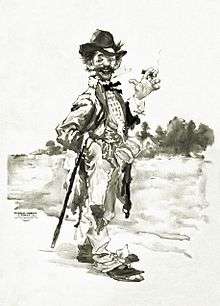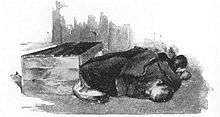Tramp
A tramp is a long-term homeless person who travels from place to place as a vagrant, traditionally walking all year round.
| Look up tramp in Wiktionary, the free dictionary. |

Etymology
Tramp is derived from a Middle English verb meaning to "walk with heavy footsteps" (cf. modern English trample) and to go hiking.
In Britain the term was widely used to refer to vagrants in the early Victorian period. The social reporter Henry Mayhew refers to it in his writings of the 1840s and 1850s. By 1850 the word was well established. In that year Mayhew described "the different kinds of vagrants or tramps" to be found in Britain, along with the "different trampers' houses in London or the country". He distinguished several types of tramps, ranging from young people fleeing from abusive families, through to people who made their living as wandering beggars and prostitutes.[1]
In the United States, the word became frequently used during the American Civil War, to describe the widely shared experience of undertaking long marches, often with heavy packs. Use of the word as a noun is thought to have begun shortly after the war. A few veterans had developed a liking for the "call of the road". Others may have been too traumatised by war time experience to return to settled life.[2]
History

Wanderers have existed since ancient times. The modern concept of the "tramp" emerges with the expansion of industrial towns in the early nineteenth century, with the consequent increase in migrant labor and pressure on housing. The common lodging house or "doss house" developed to accommodate transients. Urbanisation also led to an increase in forms of highly marginalized casual labor. Mayhew identifies the problem of "tramping" as a particular product of the economic crisis of the 1840s known as the Hungry Forties. John Burnett argues that in earlier periods of economic stability "tramping" involved a wandering existence, moving from job to job which was a cheap way of experiencing adventures beyond the "boredom and bondage of village life".[3]
The number of transient homeless people increased markedly in the U.S. after the industrial recession of the early 1870s. Initially, the term "tramp" had a broad meaning, and was often used to refer to migrant workers who were looking for permanent work and lodgings. Later the term acquired a narrower meaning, to refer only to those who prefer the transient way of life.[2] Writing in 1877 Allan Pinkerton said:
"The tramp has always existed in some form or other, and he will continue on his wanderings until the end of time; but there is no question that he has come into public notice, particularly in America, to a greater extent during the present decade than ever before."[4]
Author Bart Kennedy, a self-described tramp of 1900 America, once said "I listen to the tramp, tramp of my feet, and wonder where I was going, and why I was going."[5][6] John Sutherland (1989) said that Kennedy "is one of the early advocates of 'tramping', as the source of literary inspiration."[6]
The tramp became a character trope in vaudeville performance in the late 19th century in the United States. Lew Bloom claimed he was "the first stage tramp in the business".[7]
Meaning promiscuous woman
Perhaps because female tramps were often regarded as prostitutes, the term "tramp" when used for females came to be used to refer to a promiscuous woman. This is largely an Americanism and not in global usage.[8] According to Australian linguist Kate Burridge, the term shifted towards this meaning in the 1920s, having previously predominantly referred to men, it followed the path of other similar gender neutral words (such as "slag") to having specific reference to female sexual laxity.[9]
The word is also used, with ambiguous irony, in the classic 1937 Rodgers and Hart song The Lady Is a Tramp, which is about a wealthy member of New York high society who chooses a vagabond life in "hobohemia".[10] Other songs with implicit or explicit reference to this usage include The Son of Hickory Holler's Tramp and Gypsys, Tramps & Thieves. The use of the word with the explicitly sexual meaning is especially common in hip hop culture.[11]
See also
- Backpacker tourism, a form of low-cost, independent travel
- Bum (disambiguation)
- W. H. Davies, a British tramp and later author of The Autobiography of a Super-Tramp in the UK
- Down and Out in Paris and London, a memoir of George Orwell's experiences as a tramp in London
- Christopher McCandless, an American hiker known as "Alexander Supertramp" and the subject of the biography Into the Wild.
- Swagman, an Australian itinerant labourer
- The Tramp, a famous comic character created by Charlie Chaplin
- Tramp trade, ships with no fixed itinerary that contract on a voyage-by-voyage basis.
References
- "Victorian London - Publications - Social Investigation/Journalism - The Morning Chronicle : Labour and the Poor, 1849-50; Henry Mayhew - Letter XXX". victorianlondon.org.
- DePastino, Todd (2005). Citizen Hobo: How a Century of Homelessness Shaped America. Chicago University Press. pp. 1–48. ISBN 0226143791.
- Burnett, J., Idle Hands: The Experience of Unemployment, 1790-1990, Routledge, 2002, p.128.
- Pinkerton, Allan (1877). Strikers, Communists, Tramps and Detectives, New York: G.W. Carleton & Co.
- Kennedy, Bart (1900). A man adrift: being leaves from a nomad's portfolio. Chicago: H.S. Stone. p. 161.
- John Sutherland. "Kennedy, Bart" in Companion to Victorian Literature. Stanford University Press, 1989.
- DePastino, Todd. Citizen Hobo: How a Century of Homelessness Shaped America. Chicago: University of Chicago Press, 2003: 157
- "tramp definition, meaning - what is tramp in the British English Dictionary & Thesaurus - Cambridge Dictionaries Online". cambridge.org.
- Kate Burridge, Blooming English: Observations on the Roots, Cultivation and Hybrids of the English Language, Cambridge University Press, 2004, p.60.
- Gary Marmorstein, A Ship Without A Sail: The Life of Lorenz Hart, Simon and Schuster, 2013, p.298.
- Forman, M & Neal, M.A., That's the Joint!: The Hip-hop Studies Reader, Psychology Press, 2004, p.279.
External links
| Look up tramp in Wiktionary, the free dictionary. |
| Wikimedia Commons has media related to tramps. |
- BBC Wales feature on tramps as gentlemen of the road from 1964
- Tramp's signs, symbols and slang
- "Waiting for a Train" Excerpt from Douglas Harper's Good Company: A Tramp Life (2006) [1986] ISBN 978-1-59451-184-4
- In Strange Company, by James Greenwood, 1874 - A Tramp to the Derby
- In Search of the American Hobo at virginia.edu